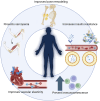Growth hormone and aging: a clinical review
- PMID: 40260058
- PMCID: PMC12009952
- DOI: 10.3389/fragi.2025.1549453
Growth hormone and aging: a clinical review
Abstract
Aging is a complex biological process characterized by functional decline, reduced quality of life, and increased vulnerability to diseases such as type 2 diabetes, cardiovascular conditions, neurodegeneration, and cancer. Advances in medical technology have introduced the concept of aging therapies, with growth hormone (GH) and its primary mediator, insulin-like growth factor 1 (IGF-1), receiving considerable attention for their potential to counteract age-related physiological and metabolic changes. GH plays a multifaceted role in the human body, primarily influencing body composition by increasing muscle mass, reducing fat tissue, promoting bone formation, and regulating the metabolism of proteins, lipids, and glucose. Additional effects have been noted on endothelial function, cognitive performance, and circadian rhythms. This review examines the molecular mechanisms of GH in aging, its potential as an anti-aging therapy, and findings from clinical trials involving these hormones for this purpose. It also addresses the associated adverse effects, limitations, and controversies. While some studies report significant benefits, these therapies' long-term safety and efficacy in promoting healthy aging remain uncertain, highlighting the need for further research.
Keywords: aging; anti-aging treatments; human growth hormone; human growth hormone deficiency; insulin-like growth factor I.
Copyright © 2025 Fernández-Garza, Guillen-Silva, Sotelo-Ibarra, Domínguez-Mendoza Barrera-Barrera SA and Barrera-Saldaña.
Conflict of interest statement
Authors LF-G, FG-S, MS-I, AD-M, SB-B, and HB-S were employed by Innbiogem SC.
Figures


Similar articles
-
Endocrine and metabolic effects of long-term administration of [Nle27]growth hormone-releasing hormone-(1-29)-NH2 in age-advanced men and women.J Clin Endocrinol Metab. 1997 May;82(5):1472-9. doi: 10.1210/jcem.82.5.3943. J Clin Endocrinol Metab. 1997. PMID: 9141536 Clinical Trial.
-
Effects of single nightly injections of growth hormone-releasing hormone (GHRH 1-29) in healthy elderly men.Metabolism. 1997 Jan;46(1):89-96. doi: 10.1016/s0026-0495(97)90174-8. Metabolism. 1997. PMID: 9005976 Clinical Trial.
-
AMERICAN ASSOCIATION OF CLINICAL ENDOCRINOLOGISTS AND AMERICAN COLLEGE OF ENDOCRINOLOGY GUIDELINES FOR MANAGEMENT OF GROWTH HORMONE DEFICIENCY IN ADULTS AND PATIENTS TRANSITIONING FROM PEDIATRIC TO ADULT CARE.Endocr Pract. 2019 Nov;25(11):1191-1232. doi: 10.4158/GL-2019-0405. Endocr Pract. 2019. PMID: 31760824
-
Dietary glycation compounds - implications for human health.Crit Rev Toxicol. 2024 Sep;54(8):485-617. doi: 10.1080/10408444.2024.2362985. Epub 2024 Aug 16. Crit Rev Toxicol. 2024. PMID: 39150724
-
Is the somatopause an indication for growth hormone replacement?J Endocrinol Invest. 1999;22(5 Suppl):142-9. J Endocrinol Invest. 1999. PMID: 10442584 Review.
References
-
- Amato G., Mazziotti G., Di Somma C., Lalli E., De Felice G., Conte M., et al. (2000). Recombinant growth hormone (GH) therapy in GH-deficient adults: a long-term controlled study on daily versus thrice weekly injections. J. Clin. Endocrinol. Metab. 85 (10), 3720–3725. 10.1210/jcem.85.10.6881 - DOI - PubMed
-
- Antonijevic I. A., Murck H., Frieboes R. M., Barthelmes J., Steiger A. (2000). Sexually dimorphic effects of GHRH on sleep-endocrine activity in patients with depression and normal controls - part I: the sleep eeg. Sleep. Res. Online 3 (1), 5–13. PMID: 11382894. - PubMed
-
- Arvat E., Gianotti L., Grottoli S., Imbimbo B. P., Lenaerts V., Deghenghi R., et al. (1994). Arginine and growth hormone-releasing hormone restore the blunted growth hormone-releasing activity of hexarelin in elderly subjects. J. Clin. Endocrinol. Metab. 79 (5), 1440–1443. 10.1210/jcem.79.5.7962341 - DOI - PubMed
Publication types
LinkOut - more resources
Full Text Sources
Miscellaneous

